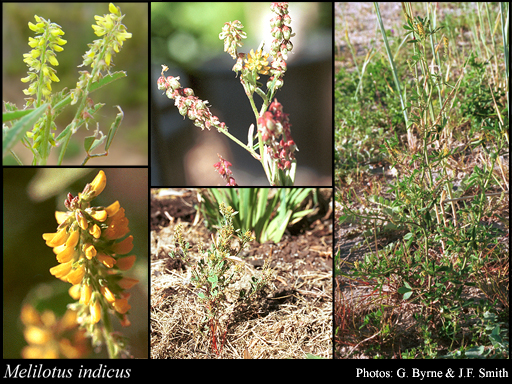- Reference
- Fl.Pedem. 1:308 (1785)
- Conservation Code
- Not threatened
- Naturalised Status
- Alien to Western Australia
- Name Status
- Current
Erect or sprawling annual or biennial, herb, 0.1-0.5(-1) m high. Fl. yellow, Aug to Dec or Jan to May. Black sandy clay, yellow sandy soils, limestone. Coastal dunes, river & creek banks, road verges.

Scientific Description
Erect, herb. Stems terete, not spiny, glabrous; pustules or glands absent. Leaves or phylloclades clearly present, compound, alternate, continuous with stem, 15-50 mm long, glabrous, with simple hairs, flat with flat margins; margins dentate; tubercles absent, pinnately arranged, terminal leaflet present, stalked; pustules or glands absent. Stipules present and persistent to older leaves, 4-7 mm long, without glands, ribless. Pedicel present, 0.6-1 mm long, glabrous. Bracteoles absent. Calyx 1.4-1.6 mm long, not accrescent, glabrous, ribless; pustules or glands absent. Corolla 2.4-3.2 mm long, uniformly coloured, yellow; claws present; standard 2-2.2 mm long, glabrous, not auriculate, wings 2-2.2 mm long, not auriculate, keel 1.5-2 mm long, not beaked, not auriculate. Stamens ten, at two different levels (filaments alternately long and short); filaments united in an open sheath with one free stamen, 1.5-2 mm long. Ovary stipitate or sessile or subsessile, glabrous; style 2-2.7 mm long, glabrous, not bearded, terete. Fruit indehiscent and splitting into sections (schizocarps), stipitate or sessile or subsessile, not constricted between the seeds, round in cross-section, not beaked. Flowers in January, February, March, April, May, August, September, October, November and December. Occurs in the Eremaean and South-West Botanical Province, in the Carnarvon, Yalgoo, Coolgardie, Geraldton Sandplains, Avon Wheatbelt, Jarrah Forest, Warren, Esperance and Swan Coastal Plain IBRA regions.
Distribution
- IBRA Regions
- Avon Wheatbelt, Carnarvon, Coolgardie, Esperance Plains, Geraldton Sandplains, Jarrah Forest, Swan Coastal Plain, Victoria Bonaparte, Warren, Yalgoo.
- IBRA Subregions
- Dandaragan Plateau, Edel, Fitzgerald, Geraldton Hills, Katanning, Keep, Mardabilla, Northern Jarrah Forest, Perth, Recherche, Southern Jarrah Forest, Warren, Wooramel.
- IMCRA Regions
- Abrolhos Islands, Central West Coast, Leeuwin-Naturaliste, WA South Coast.
- Local Government Areas (LGAs)
- Albany, Augusta Margaret River, Bunbury, Busselton, Cambridge, Capel, Carnarvon, Chapman Valley, Chittering, Cockburn, Dandaragan, Denmark, Esperance, Gingin, Greater Geraldton, Mandurah, Melville, Mundaring, Murray, Nedlands, Northam, Northampton, Perth, Ravensthorpe, Rockingham, Shark Bay, South Perth, Stirling, Subiaco, Swan, Wanneroo, Waroona, Wongan-Ballidu, Wyndham-East Kimberley.
Management Notes (for the Swan NRM Region)
Alternative Names. Indian Sweet-clover, Small Melilot, Sour-clover, Yellow Sweet Clover.
General Biology. Growth form. Herb. Life form. Annual. Reproduction. Seed. Dispersal. Water, wind. Toxicity. Poisonous to mammals. Seedbank persistence. Possibly 20+ years.
Notes. Can be biennial. Widely naturalised throughout the world. Weed of highly disturbed bushland, occurring in a wide range of habitats. Grows in moderately saline areas. Has high nodulation and nitrogen-fixing capacity. Leaves can solar-track throughout the day.
Additional information. Origin. Western Asia, middle, temperate and tropical Asia, Indian subcontinent, southern Europe, northern Africa, Macronesia. History of use/introduction. Honey production, erosion control, soil improver, forage, medicines.
Suggested method of management and control. Hand remove small/isolated populations. If slashing cut below lowest branch axil to prevent resprouting. Read the manufacturers' labels and material safety data sheets before using herbicides. For further information consult the Australian Pesticides and Veterinary Medicines Authority to determine the status of permits for your situation or state.
Management Calendar
| Calendar Type | Jan | Feb | Mar | Apr | May | Jun | Jul | Aug | Sep | Oct | Nov | Dec | Comments |
|---|---|---|---|---|---|---|---|---|---|---|---|---|---|
| Germination | |||||||||||||
| Active Growth | Y | Y | Y | Y | Y | Y | |||||||
| Flowering | Y | Y | Y | Y | Y | Y | Y | Y | Y | Y | |||
| Fruiting | |||||||||||||
| Manual Removal | O | O | O | O | O | O |
Legend: Y = Yes, regularly, O = Occasionally, U = Uncertain, referred by others but not confirmed.
References
- Al Sherif, E.A. (2009) Melilotus indicus (L.) All., a salt-tolerant wild leguminous herb with high potential for use as a forage crop in salt-affected soils. Flora, 204: 737-746.
- Brown, K. & Brooks, K. (2002) Bushland Weeds: A Practical Guide to their Management. Environmental Weeds Action Network, Greenwood.
- Emms, J., Virtue, J.G., Preston, C.T. & Bellotti, W.D. (2005) Legumes in temperate Australia: A survey of naturalisation and impact in natural ecosystems. Biological Conservation, 125: 323-333.
- Hussey, B.M.J., Keighery, G.J., Dodd, J., Lloyd, S.G. & Cousens, R.D. (2007) Western Weeds. A guide to the weeds of Western Australia. 2nd Edition. The Plant Protection Society of Western Australia, Victoria Park.
- Schwartz, A., Gilboa, S. & Koller, D. (1987) Photonastic control of leaflet orientation in Melilotus indicus (Fabaceae). Plant Physiology, 84: 318-323.
- Spira, T.P. & Wagner, L.K. (1983) Viability of seeds up to 211 years old extracted from adobe brick buildings of California and northern Mexico. American Journal of Botany, 70 (2): 303-307.
- Swarbrick, J.T. & Skarratt, D.B. (1994) The bushweed 2 database of environmental weeds in Australia. The University of Queensland, Gatton College.
- USDA, ARS, National Genetic Resources Program (2009) Germplasm Resources Information Network - (GRIN). National Germplasm Resources Laboratory, Beltsville, Maryland. URL: https://npgsweb.ars-grin.gov/gringlobal/taxon/taxonomysimple.aspx - Accessed October 2009.